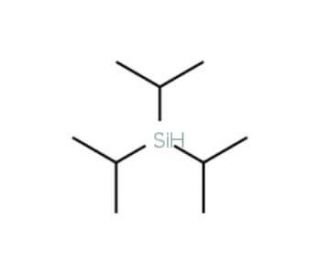

Triisopropylsilane 의 분자 구조, CAS 번호: 6485-79-6
Triisopropylsilane (CAS 6485-79-6)
대체 이름:
TIS; Tris-isopropylsilane
적용:
Triisopropylsilane 는 75220anti95064-1,2-디올을 제조하는 데 사용할 수 있는 고도로 선택적인 환원제입니다.
CAS 등록번호:
6485-79-6
순도:
≥98%
분자량:
158.36
분자식:
C9H22Si
추가 정보:
운송용 위험물로 분류되어 추가 배송료가 부과될 수 있습니다.
연구용으로만 사용가능합니다. 진단이나 치료용으로 사용불가합니다.
* Refer to Certificate of Analysis for lot specific data.
빠른 링크
주문정보
설명
기술정보
안전정보
SDS 및 분석 증명서
트리이소프로필실란은 환원제입니다. 케톤, 에스테르, 아미드와 같은 다양한 작용기를 환원하는 강력하고 선택적인 환원제 역할을 합니다. 작용 메커니즘은 수화물 이온을 기질로 전달하여 해당 알코올 또는 아민을 형성하는 것입니다. 트리이소프로필실란은 온화한 반응 조건으로 인해 염화산 및 에폭사이드와 같은 민감한 작용기를 환원하는 데 특히 유용합니다.
Triisopropylsilane (CAS 6485-79-6) 참고자료
- 실리카에 결합된 상 리간드의 표면 커버리지: 계산 연구. | Zhuravlev, ND., et al. 2001. Anal Chem. 73: 4006-11. PMID: 11534729
- (2-푸릴)-L-알라닌 함유 펩타이드의 안정성 및 절단 조건. | Schulz, A., et al. 2004. Protein Pept Lett. 11: 601-6. PMID: 15579131
- 피리딜-S-시스테인 기능화 봄베신 유도체에 (99m)Tc(CO)3(+) 코어를 표지한 방사화학 및 방사선 생물학적 평가. | Bouziotis, P., et al. 2013. Bioorg Med Chem. 21: 6699-707. PMID: 24035515
- 연체동물을 사냥하는 원뿔달팽이 코누스 섬유에서 추출한 독의'코노노믹' 분석-번역 후 변형의 약리학적인 중요성. | Bergeron, ZL., et al. 2013. Peptides. 49: 145-58. PMID: 24055806
- 새로운 G 단백질 결합 수용체 키나아제 2 억제제의 설계, 합성 및 효능. | Carotenuto, A., et al. 2013. Eur J Med Chem. 69: 384-92. PMID: 24077529
- 트리이소프로필실란에 의한 시스테인-S-보호기의 감소. | Ste Marie, EJ. and Hondal, RJ. 2018. J Pept Sci. 24: e3130. PMID: 30353614
- 펩타이드 알콜 합성을 위한 기능화 수지. | Ferrer-Gago, FJ., et al. 2020. Chemistry. 26: 379-383. PMID: 31609031
- 2,2'-디피리딜 디셀레니드: 시스테인 탈보호 및 디설파이드 결합 형성을 위한 화학 선택적 도구. | Ste Marie, EJ. and Hondal, RJ. 2020. J Pept Sci. 26: e3236. PMID: 31856422
- 금 나노 입자의 결정화에서 핵 형성 전 클러스터의 역할. | Ramamoorthy, RK., et al. 2020. Nanoscale. 12: 16173-16188. PMID: 32701100
- 선택적 온수지 탈리화를 위한 퍼플루오로-터트-부탄올: 기존에 사용되던 방법에 대한 순한 대안입니다. | Wester, A., et al. 2021. Amino Acids. 53: 1455-1466. PMID: 34410506
- 트리이소프로필실란의 존재 하에서 이중 노어 사이클로라이제이션을 이용한 디아자퀴노마이신 H 및 J의 총합성. | Prior, AM. and Sun, D. 2019. RSC Adv. 9: 1759-1771. PMID: 35516148
- 펩타이드 지질화에 적용한 S-보호 시스테인 설폭사이드-활성화 트립토판 선택적 변형. | Kobayashi, D., et al. 2022. ACS Med Chem Lett. 13: 1125-1130. PMID: 35859873
- 니켈 촉매를 이용한 비닐리덴 디플루오라이드(CH2═CF2)의 동형화: 선택적 β-F 대 β-H 제거. | Sicard, AJ., et al. 2022. J Am Chem Soc. 144: 22713-22721. PMID: 36469940
주문정보
| 제품명 | 카탈로그 번호 | 단위 | 가격 | 수량 | 관심품목 | |
Triisopropylsilane, 10 g | sc-296622 | 10 g | $36.00 | |||
Triisopropylsilane, 50 g | sc-296622A | 50 g | $78.00 |
